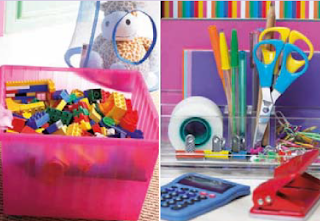The bottom-line test for organization is function. Does your house work for you?
Can you find things, carry out tasks, and live daily life without stress? To organize a home, follow the three rules of home organization: a place for everything, bring the family on board, and create centers for household activities.
1- A place for everything.
It’s an old saw, but it still cuts: “A place for everything, and everything in its place” is a
watchword for true home organization. Possessions, like people, need homes. Find them that home, defend their turf with labels, dividers, and organizers, and you’ve won most of the battle for an organized home.
“It’s an old saw, but it still cuts: ‘A place for everything, and everything in its place.’”
Be creative when it comes to finding homes for household stuff—and rearrange your thinking. So what if stores sell towels in matched sets of three? Break up the trio and store them where they’re needed: hand towels stacked in washrooms near living areas; bath towels and washcloths in the bathroom where they’re most used. Don’t hide pizza coupons and take-out menus away in a kitchen drawer where they’ll get forgotten: store them in a folder near the phone where they’ll be most useful.
2- Bring the family on board.
Getting organized is not simply a matter of domestic real estate; it’s an integrated process involving all members of the household. Any organizing scheme or system will fail unless all family members understand it and can follow it. Bring the family on board as you organize your stuff and your surroundings. For example, when organizing where to put items in the kitchen, store plates, bowls, and unbreakable glasses in low cabinets. Younger family members can set the table only if they can reach the dishware; by storing tableware
in an accessible place for them, you’ll be helping all of the family to help you.
3- Create “centers” for household activities.
Looking for a model of a well-organized home?
Head back to preschool! Preschool teachers are model organizers because they have to be. Without a plan
for classroom structure, 18 or 20 energetic little people could create plaything havoc in mere moments.
To keep their schoolroom running smoothly, preschool teachers apply the concept of “centers”: dedicated areas for a single activity, like blocks, dress-up, or sand play, with storage for all the playthings required by that activity. In the playhouse, kitchen toys, pots, and pans encourage role-playing; at the art table, paper, paints, and brushes are within easy reach. At pick-up time, children know to return costumes to the dressup
pole, and park the trucks in the “parking lot” storage area.
On the domestic front, you can set up centers that work the same way, to focus and support the everyday activities that are carried on in the home. To create them, you’ll designate:
▪ A focus. Allocate one focused activity to each center.
▪ A specified area. Set aside a single place to perform the activity.
▪ Storage for tools and supplies. Ensure that all items needed are present and available in the center.


Enregistrer un commentaire